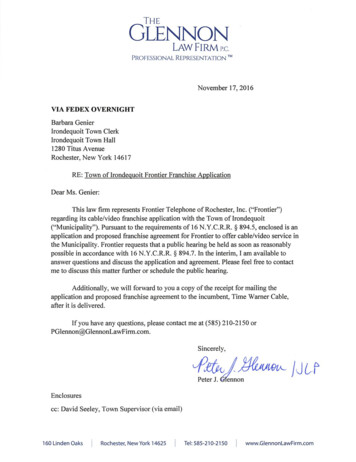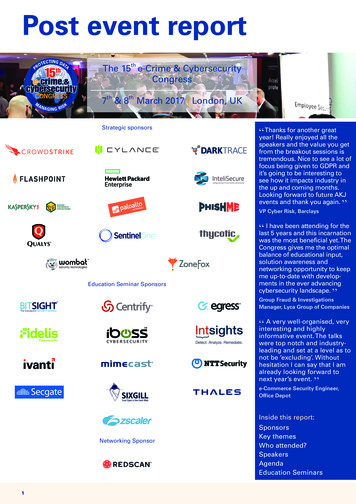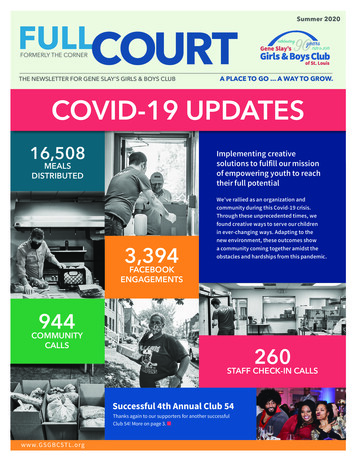
Transcription
THEGlennon Aw Firm p.C.PROFESSIONAL REPRESENTATION November 17, 2016VIAFEDEXOVERNIGHTBarbara GenierIrondequoit Town ClerkIrondequoit Town Hall1 2 8 0 Ti t u s Av e n u eRochester, New York 14617RE: Town of Irondequoit Frontier Franchise ApplicationDear Ms. Genier:This law firm represents Frontier Telephone of Rochester, Inc. ("Frontier")regarding its cable/video franchise application with the Town of Irondequoit("Mimicipality"). Pursuant to the requirements of 16 N.Y.C.R.R. § 894.5, enclosed is anapplication and proposed franchise agreement for Frontier to offer cable/video service inthe Municipality. Frontier requests that a public hearing be held as soon as reasonablypossible in accordance with 16 N.Y.C.R.R. § 894.7. In the interim, I am available toanswer questions and discuss the application and agreement. Please feel free to contactme to discuss this matter further or schedule the public hearing.Additionally, we will forward to you a copy of the receipt for mailing theapplication and proposed franchise agreement to the incumbent, Time Warner Cable,after it is delivered.If you have any questions, please contact me at (585) 210-2150 cc: David Seeley, Town Supervisor (via email)160 Linden Oaks i Rochester, New York 14625 I Tel: 585-210-2150 1 www.GlennonLawFirm.com
F O R A C A B L E T E L E V I S I O N F R A N C f fl S EFrontier Telephone of Rochester, Inc. ("Frontier") respectfiilly files this application for acable television franchise with the Town of Irondequoit, New York ("Town of Irondequoit" orthe "Town").Background:Overview of FrontierFrontier's motto is "We can help!" Frontier goes the extra mile for our customers and isextremely proud to serve our communities. Local engagement is more than a strategy toFrontier. It is in our DNA. Broadband and communications are central parts of daily lifeand are requirements for our communities to thrive and grow. Frontier takes seriouslyour responsibility to reliably deliver these services to the millions of customers we serve.Frontier's parent company is Frontier Communications Corporation, FrontierCommunications Corporation is an S&P 500 company and is included in the Fortune1000 list of America's largest corporations. Frontier serves a mix of urban, suburban,and rural areas in 29 states across the United States. Frontier offers a variety of servicesto customers over its fiber-optic and copper networks, including video, high-speedinternet, advanced voice and Frontier Secure digital protection solutions. FrontierBusiness Edge offers communications solutions to small, medium, and enterprisebusinesses.F r o n t i e r ' s Va l u e sFrontier is committed to its core value of being the leader in providing communicationsservices to residential and business customers in its markets by putting our customersfirst, treating our customers, business partners, and employees with respect, keeping ourcommitments, being accountable at all times, being ethical in all of ours dealings, beinginnovative and taking the initiative, being a team player, being active in our communities,doing right the first time and continuously improving, using resources wisely and alwayshaving a positive attitude.Overview of FrontierFrontier is one of New York's largest incumbent local exchange carriers and our NewYork infirastructure is critical to residential customers and to the success of businesses1IPage{00217838.DOCX/1}
large and small, educational institutions, healthcare facilities and public safety agenciesin the communities we serve. Frontier's network is essential to the support of othertelecommunications (such as wireless carriers) and information service providers. AllFrontier products and services offer 24/7/365 support from a 100% U.S.-basedworkforce.Frontier employees live and work in the New York communities they serve. They are ourcustomers' friends and neighbors and the subject matter experts on the bestcommunications technology for home and business. They are customer-focused andempowered to make the right decisions for the customer. Employees support programsand initiatives important to their communities and live Frontier's values every day.Frontier is deeply committed to the communities we serve. Examples include: One of the top 20 employers in the Finger Lakes Region Naming rights for Frontier Field Creator and supporter of America's Best Communities program, whichgives an opportunity for communities to win funding to support localinitiatives to improve their communities. Three Finger Lakes areacommunities participated in submitting community improvement plans. Chamber of Commerce involvement throughout the Finger Lakes Region Committed to hiring of veterans, an Honor and Remember supporter andevent sponsor Employee participation and leadership in United Way events. Relay forLife, Day of Caring and many other local community events.Frontier's Commitment to Our CustomersEach of Frontier's markets across the 29 states we serve has a General Manager who ispersonally accountable for delivering extraordinary service. Decisions are made at thelocal level taking into account local needs and interests. In the Rochester/Finger Lakesarea, the Area General Managers are Bill Carpenter and Claudia Maroney. Frontier'sSenior Vice-President/General Manager for New York is Elena Kilpatrick. Frontier'sregional, state and local leadership are actively involved in day-to-day operations andpersonally see to it that customers in their markets are receiving our best. From the CEOdown, we are all accountable to our customers every day. When storms or naturaldisasters strike our regions, we are among the first to respond, and have the nationalresources to call upon. When members of our community fall on tough times, we prideourselves on being there to support them. Our technicians work around the clock in sometough conditions to keep your services running smoothly. Know that when a personbecomes a Frontier customer, they are signing up for over 28,600 employees at thenback. Every day, our employees put the customer first.{00217838.DOCX /1}2IPage
F r o n t i e r ' s C o m m i t m e n t t o Ve t e r a n sFrontier is also an award-winning veteran employer and proud to support those whoserved our nation. More than 1 out of every 10 Frontier employees is a veteran, reservist,and/or the spouse of a veteran. Frontier is a member of The Military SpouseEmployment Partnership, The 100,000 Jobs Mission, The Employer Partnership of theArmed Forces, Honor and Remember, and Joining Forces.IncorporationFrontier Telephone of Rochester, Inc., the applicant, is a New York Corporation in goodstanding and authorized to do business in the State of New York.The following responds directly to the information required by New York StateDepartment of Public Service Regulation Section 894.5 (16 NYCRR §894.5)A. The following provides a general description of the technology andinfrastructure of the cable television system proposed to be constructed:Frontier Communications' Vantage TV video offering is powered by Ericsson'sMediaroom software platform. Mediaroom is the world's #1 IPTV platform - one that isproven and widely adopted by Network Service Providers worldwide - with over 16.4million subscriber households and 32 million connected devices running the software todate. Vantage TV is an innovative, scalable, and highly reliable video service designedto run over our IP enabled networks (xDSL, FTTP/FTTN, etc.). Our customers'satisfaction has been extremely high to date - relative to our competitor's video offeringsin the same markets in which we are deployed.Vantage TV's core product features include: Secure delivery of SD (Standard Definition), HD (High Definition)and 4KAJHD (Ultra Hi Definition) content - via integrated DigitalRights Management - to set-top Boxes on each TV. Superior HD, SD & UHD picture quality. WiFi-enabled set-top boxes are also a deployment option jillowingour customers to place their TVs wherever they want in their homes. Live TV broadcast with instant channel change allowing super-fastnavigation through our Interactive Programming Guide. Video On-Demand library that will contain more than 100,000movies and shows.{00217838.DOCX/1}3IPage
Total Home DVR records up to 6 shows at once and lets ourcustomers pause, rewind and play back live TV and store over 170hours of HD programming. We provide our customers with up to 1Terabyte worth of on-premise storage capacity. Next generation EPG (Electronic Program Guide) and enhancedsearch functionality deliver real time results with a rich, new visualposter-art driven experience that allows our customers to easilydiscover and consume content on their terms. Integrated interactive applications include Social TV (access toTwitter and Facebook), Weather, Interactive Workout, HomeShopping Network and interactive games.It is important to note that Vantage TV is more than just a "middleware" or a UserInterface; it is an end-to-end platform that covers all video functional dependenciesstarting from Content Acquisition all the way through to Service Consumption. These aredescribed below:Content Acquisition: Frontier processes Live and On-Demand content through encodersand content packaging tools at our Video Headend in Fort Wayne, Indiana and VideoServing Offices (VSOs) in markets that we serve. Acquisition Servers (A-Servers) inour service delivery architecture encrypt streams, encapsulate in RTP and/or SmoothStreaming format, and put multicast streams out on our network for devices to seamlesslyconnect to and consume content.Content Protection: Frontier secures all of the content it received through leveragedDigital Rights Management (DRM) and Public Key Infrastructure (PKI) systems, whichin turn, establishes trust across its entire server environment and its set-top Box clients.Service Management. Vantage TV leverages a complex TV Services management toolto configure and manage subscriber information. Live TV Services, Channel Line-Up /Channel Maps, and Video On Demand Services all from a web-based interface that ourVideo Operations team controls.Subscriber Management: Frontier integrates Vantage TV with our internal Billing andProvisioning systems (OSS/BSS) in a seamless fashion to ensure the most efficientcustomer experience. We continuously monitor the system end to end and managesubscriber groups, entitlements, and user authentication to all content and packages,while at all times protecting customer informationA subscriber group is essentially a category to which one or more client set-top boxesare associated with. For example, a single client device might be in the followingsubscriber groups: "HD-capable," "Premium Content Package," and/or "SuburbanIllinois metro area."{00217838.DOCX/1}4IPage
Subscriber groups also have Server clusters associated with them (for VOD and LinearTV Services). For example "South Metro" might be used to associate a subscriber groupto a set of live channels, public-access channels, and correlated to a specific set of videodistribution servers that provide content.The TV Services Management tool then offers the ability to associate clusters of Serverswith a subscriber group and to associate subscriber groups with client devices(propagating associated content rights and entitlements).Service Delivery: Frontier delivers high-quality Live and Video-on-Demand contentover our Managed IP Network to the customer premise. Distribution Servers (D-Servers)in our service delivery architecture buffer streams, generate instant channel changebursts, and do forward error packet correction.Service CoDsumption: Frontier presents content to our customers' TVs in a secure andreliable manner through Vantage TV's client software. That software, which decrypts thestream (via SOC / System on a Chip), resides directly on our customers' set-top boxes.In summary, Vantage TV is an end to end software solution that enables Frontier to delivernext-generation TV experiences including standard and high-definition/ultra-high-definition live TV channels, video-on-demand (VOD), digital video recording VR) andconnected entertainment experiences to our customers.The following responds directly to the requested information set forth in the Request forProposals regarding a description of the proposed system design and planned operation:1. Channel capacity, including both the total capability of the proposed system and thenumber of channels to be energized immediatelyFrontier's underlying technology allows for an almost unlimited channel capacity.While a final channel lineup has not been finalized at this time, please see "ExhibitA- channel lineup and programming packages" fi:om another jurisdiction Frontieroffers service. Frontier will provide the Town with a copy of the actual channel{00217838.D0CX/1}51Page
lineup prior to launching service. Frontier also provides a robust library of Video onDemand content.2. Television and radio broadcast signals which the applicant intends to carry on itssystem initiallyFrontier vrill make all appropriate filings and preparations prior to the turn up of itsvideo service including (1) filing a community registration with the FCC via FCCForm 322; (2) providing notice to local broadcasters and requesting either mustcarry or retransmission consent election.In its existing markets. Frontier complies with many additional federal requirementsin providing its service, including all of the FCC requirements applicable tomultichannel video programming distributors (such as equal employmentopportunity and set-top box requirements), the FCC requirements applicable to HASparticipants that are wireline video service providers, other FCC requirementsapplicable to provision of Vantage TV (Frontier Broadband Service in New York)(such as receive-only earth station license requirements and annual regulatory feesfor IPTV providers), and the Copyright Office requirements for cable systems filingsemi-annual copyright statements of accounts and paying statutory license fees.Frontier does not file an FCC Form 327 relating to CARS microwave facilitiesbecause Frontier does not use such facilities in connection with the provision ofVantage TV. Similarly, Frontier does not file FCC Form 320 and FCC Form 321 asthey relate to the use of aeronautical fi*equencies that are not applicable to the IPTVtechnology.In these areas where Frontier offers service, area. Frontier will use existingretransmission or must carry agreements for the Rochester, NY Designated MarketArea (DMA).The planned carriage of these stations could include both primary and multicastsignals of each station.3. Extent and type of any origination cablecasting to he undertaken, and the facilities,equipment and staff to he employed therein; andi. Location of antennae and headend(s)Frontier has a "super head end" in Fort Wayne, Indiana which has asatellite "farm" used to download national content. This super head endhas redundancy to receive terrestrial secondary feeds from Verizon, i.e.,should an emergency interrupt service from one of its national contentsources. The national content is encoded and then deployed over diverse10 GIG circuits to the local head where the local content, including public,educational and government access charmels, is inserted for delivery to endusers. Customers in the Town will be served out of the head end in Fort{00217838.DOCX/1}6IPage
Wayne, Indiana and a local head end in Rochester, New York. Frontierwill pick up the local broadcast signals via fiber circuits and/or will alsocapture those signals by antennae located at the local head end and /or as aback-up, precautionary measure.ii. Plans for two-way capability, including a proposed scheduled indicating whentwo-way capability will become available from particular points;While an exact launch date has yet to be determined. Frontier is workingdiligently to complete all necessary work and required testing andoperational readiness reviews to offer service to customers upon successfulexecution of a Franchise Agreement. Frontier will meet with Commissionand appropriate member jurisdictions to share the actual launch date when itbecomes alized.iii. Location of origination points and origination facilitiesTo be determined based on discussion with the Town.iv. Extent and type of automated services to be provided; andAs noted in Section B above. Frontier has provided a sample channellineup. See Exhibit A. This illustrates the vast selection of contentavailable to subscribers.Vantage TV offers:Incredible 100% digital picture and sound.Total-home DVR with ability to record up to six shows at once and view onany TV with a set-top box.Instant channel change and super-fast navigation through our interactiveprogram guide and Video on Demand.The ability to watch up to six different channels at once with Multi-View.The ability to Pause, Fast Forward, Rewind live or recorded shows on up toeight TVs in your house.Next generation enhanced search which delivers real-time results by programname, actor/actress and other keywords across Live TV, Video On Demandand DVR recordings.Introducing Channel Peeks which maintains full-screen viewing while"peeking" into other programming.{00217838.DOCX/1}7IPage
Recent & DVR Peek allows you to preview and tune to any of the last fivechannels or DVR recordingsNumber of channels to be utilized for access cablecasting, and the facilities,equipment, staff and other support to be available to access users including accessutilization or production costs.V. Number of channels to be utilized for access cablecasting, and the facilities,equipment, staff and other support to be available to access users includingaccess utilization or production costs.Frontier will carry the same number of PEG stations as the incumbent.Frontier will make all franchised municipalities' access channelsavailable to its subscribers. For purposes of acquiring the signal,Frontier will pick up the particular municipality's access channel signalsat the point(s) of origination via fiber facility and transport such contentback to the local VSO for insertion in the channel lineup. At thepoint(s) of origination, Frontier will need rack space and power for itsequipment to receive the signal(s) handed off by the Town toFranchisee. Franchisee will pay for all facilities and equipment locatedon its side of the demarcation point where the Town will hand off itscontent to Franchisee and as is industry practice the Town will beresponsible for all equipment on its side of the demarcation point.B. The terms and conditions under which service is to be provided to educational andgovernmental entities.Frontier will provide at no charge expanded basic service to all government buildings,schools, and public libraries located within its service footprint so long as those locationsare capable of receiving service from Frontier and no other cable provider is providingservice at such locations.C. Terms concerning rates and construction schedules which satisfy the requirements of 16NYCRR Part 895.1. RatesFinal rates have yet to be determined, please see "Exhibit B- sample rates" which areoffered here for illustrative purposes.2. Construction SchedulesFrontier is still finalizing its initial footprint for the deployment of cable services withinthe Town's service area. Frontier's planned deployment is highly confidential.Pursuant to an executed fi chise agreement(s). Frontier will meet regularly with theTown and the Commission to discuss where service is available and any plans for{00217838.DOCX/1}8 Pag6
additional deployment. Frontier is the second entrant into the wireline video market inthe Town. As a second entrant, investment in and expansion of Frontier's cable systemshould be driven by market success, and not a contractual requirement for ubiquitouscoverage.The following sets forth some critical background with respect to employment of bothtelecommunications and cable infrastructure. Initially, local telephone companies weregranted monopolies over local exchange service in exchange for taking on a provider oflast resort obligation- a duty to provide service - to customers in its service territory.Similarly, with respect to video services. The incumbent video provider (and itspredecessors) operated as a monopoly over facilities-based video. In exchange formaking the capital investment to deploy facilities, the incumbent cable company got100 percent of the customers who wanted cable television.Subsequently, with respect to telephone services, the federal and local governmentseffectively eliminated the local telephone monopolies and fostered robust competition. Itshould be noted that in doing so, the telecom second entrant had absolutely no obligationto build any facilities or to serve any particular location(s) at all. As the FCC noted,imposing build-out requirements on new entrants in the telecommunications industrywould constitute a barrier to entry (13 FCC Red 3460,1997). Cable companies were freeto enter the telecom market on terms that made business and economic sense to them.This very environment was the catalyst for robust wireless and wireline competition andthe proliferation of higher broadband speeds.Congress became concerned about the lack of competition in the video world and in1992 amended federal law to prohibit a local franchising authority from"unreasonably[y] refus[ing] to award an additional competitive fi chise." 47 U.S.C. §541(a)(1) provides a direct avenue for federal court relief in the event of such anunreasonable refusal. 47 U.S.C. § 555(a) and (b). Until the advent, however, of statestatutes granting statewide cable franchises without a mandatory build requirement(e.g., Florida) or progressive cities willing to grant competitive franchises, cablemonopolies continued to the detriment of consumers and competition. Level playingfield requirements are just one example of barriers to competitive entry erected bycities at the behest of the cable monopolies.Courts have ruled, however, that "level playing field" provisions do not requireidentical terms for new entrants. See, for example. Insight Communications v. Town ofLouisville, 2003 WL 21473455 (Ky. Ct. App. 2003), where the court found: There willnever be an apple-to-apple comparison for Insight and other franchisee simply becauseInsight is the incumbent which in its own right and through its predecessors has beenthe exclusive provider of cable services in the Town of Louisville for almost thirtyyears. No new cable franchisee can ever be in the same position as a thirty-yearveteran. See also, In Cable TV Fund 14-A, Ltd. v. Town ofNaperville (1997 WL209692 (N.D. 111); and JVew England Cable Television Ass'n, Inc. v. Connecticut DPUC717A.2d 1276(1998).{00217838.DOCX/1}9IPage
In sharp contrast to the monopoly provider, a second entrant faces a significant capitaloutlay with absolutely no assurance of acquiring customers; rather, it must competewith the monopoly incumbent and win each and every customer over. As ProfessorThomas Hazlett of George Mason University has explained, "[i]ncumbents advocatebuild-out requirements precisely because such rules tend to limit, rather than expand,competition." The federal Department of Justice has also noted that ".consumersgenerally are best served if market forces determine when and where competitors enter.Regulatory restrictions and conditions on entry tend to shield incumbents fromcompetition and are associated with a range of economic inefficiencies including higherproduction costs, reduced innovation, and distorted service choices." (Department ofJustice Ex Parte, May 10,2006, FCC MC Dkt 05-311)The fact is that the incumbent cable provider has (1) an established market position; (2)all of the cable customers; and (3) an existing, in-place infi tructure. These disparatemarket positions make imposing a build-out requirement on a competitive entrant badpublic policy. Under the guise of "level playing field" claims, incumbent cable operatorsseek to require new entrants to duplicate the networks the incumbents built asmonopolies, knowing that such a requirement will greatly reduce, if not eliminate, therisk of competitive entry.In 2007, the FCC issued its findings with respect to facilities based video competitionand held as follows: (1) with respect to level playing field requirements, the FCCstated that such mandates "unreasonably impede competitive entry into themultichannel video marketplace by requiring local franchising authorities to grantfi chises to competitors on substantially the same terms imposed on the incumbentcable operators (Para. 138); and (2) with respect to mandatory build out, the FCC heldthat "an LFA's refusal to grant a competitive fi chise because of an applicant'sunwillingness to agree to unreasonable build out mandates constitutes an unreasonablerefusal to award a competitive franchise within the meaning of Section 621(a)(1) [47U.S.C.i 541(a)(1)]."Those two FCC holdings alone should put this entire matter to rest - level playing fieldrequirements and unreasonable mandatory build requirements are barriers to competitiveentry in the cable market and violate the federal Cable Act and the FCC's order. NewYork, however, codified its requirements in a state law and the FCC expressly declinedto "preempt" state laws addressing the cable fi chising process.It is clear, however, that the FCC did not intend to protect the New York statute whichmandates the imposition of barriers to entry on each and every local finnchisingauthority. As various providers were trying to enter the competitive cable market andencountering barriers such as level playing field requirements and mandatory build outprovisions, many states passed statutes to facilitate competitive entry and to preventlocal finnchising authorities from erecting barriers to entry. Such laws were passed in26 states including Florida, Missouri and North Carolina, where incumbent video{00217838.DOCX/1}10 I P a g e
providers have taken advantage of the streamlined process to enter a market without amandatory build obligation. These laws have facilitated competitive entry asevidenced, for example, by the presence of four facilities based competitors in theOrlando, Florida market, including CenturyLink and Comcast. As such, these statelaws are aligned and not in conflict with the FCC's and Congress' policies forpromoting competition in the video distribution market.New York's cable law, however, is quite the opposite. New York's cable act dates backto the 1970s and directs each local franchising authority to impose not only a levelplaying field across a broad range of issues (many of which Frontier does not oppose),but also a five year mandatory build out requirement. Both of these provisions havebeen deemed to be barriers to entry by the FCC. The incontrovertible fact is that the lawhas been extremely successful in barring cable communications competition in theTown. The Town has not experienced any facilities-based competition because of thebarriers to entry New York codified in 16 NYCRR Part 895.In support of this position, that the FCC's 2007 Order preempts 16 NYCRR §895.5,Frontier notes the following: Conflict preemption: State law may be preempted without expressCongressional authorization to the extent it actually conflicts with federallaw where state law "stands as an obstacle to the accomplishment andexecution of the full purposes and objectives of Congress." English v.General Elec. Co., 496 U.S. 72, 79 (1990). Whether state law constitutes a sufficient obstacle is a matter of judgmentto be informed by examining the federal statute as a whole andidentifying its purpose and intended effects. Crosby v. Nat7 ForeignTrade Council, 530 U.S. 363 #372 (2000). 16 NYCRR §895.5 mandates terms that each municipality mustimplement in granting a new or renewed cable franchise. 16 NYCRR § 895.5(b)(1) provides "That within five years of receipt ofall necessary operating authorizations, cable television service will beoffered throughout the authorized area to all subscribers requestingservice in any primary service area. Section 621 (a)( 1) initially gave local authorities the authority to grantfranchises, but this broad grant resulted in exclusivefi chises/monopolies. Congress "believe[d) that exclusive firanchises arecontrary to federal policy . which is intended to promote thedevelopment of competition." H.R. Conf. Rep. No. 102-862, at 77(1992).{00217838.DOCX/1}11 I P a g e
Legislative history clearly supports that Congress was focused onfostering competition when it passed the 1992 Act. Qwest BroadbandServs. Inc. v. Town of Boulder, 151 F. Supp.1236,1244 (D. Colo. 2001). In its 2007 order, the FCC found that "an LFA's refusal to grant acompetitive franchise because of an applicant's unwillingness to agree tounreasonable build out mandates constitutes an unreasonable refusal toaward a competitive franchise within the meaning of Section 621(a)(1)."The FCC order, however, targeted local and not state laws. Arguably, the New York build requirements set forth in 16 NYCRR §895.5 are in conflict with Section 621(a)(1) and are, therefore,preempted. In the Boulder case, the court applied Section 62rs prohibition onunreasonable refusals to grant fr chises to find conflict preemptionwhere local rules required voter approval for any new fr chises. The mandatory build out in the New York law could be considered a defacto "unreasonable refusal" to grant a fr chise and thus conflict withthe pro-competition purpose set forth in Section 621(a)(1). In upholding the FCC's ruling, the Sixth Circuit stated that "while the[FCC] characterized build out requirements as 'eminently sensible' underthe prior regime in which cable providers were granted community-widemonopolies, under the current, competitive regime, these requirements'make entry so expensive that the prospective. provider with
Frontier Communications' Vantage TV video offering is powered by Ericsson's Mediaroom software platform. Mediaroom is the world's #1 IPTV platform - one that is proven and widely adopted by Network Service Providers worldwide - with over 16.4 million subscriber households and 32 million connected devices running the software to date. Vantage TV .










